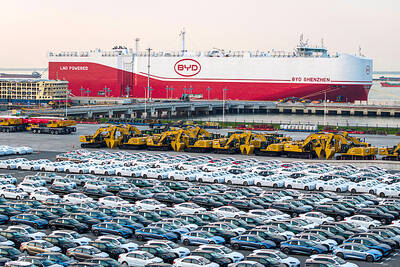Falling TV panel prices and the strengthening New Taiwan dollar have hit major Taiwanese flat-panel makers, resulting in lower sales last month and the last quarter, according to the latest company figures released last week.
While signs of a pick up in panel demand started to emerge last month, AU Optronics Corp’s (友達光電) consolidated sales last month dropped 16.95 percent from November, Chunghwa Picture Tubes Ltd (中華映管) saw its sales fall 8.77 percent and those of HannStar Display Corp (瀚宇彩晶) were 2.29 percent lower than a month earlier.
“The decrease in the December revenue was associated with the lower-than-expected TV panel prices, customer inventory control by the end of the year and the currency influence of NT dollar appreciation,” AU Optronics, the nation’s second-largest LCD panel maker, said in a statement on Friday.

PHOTO: CHEN MEI-YING, TAIPEI TIMES
Speaking to reporters at a tree-planting ceremony on Saturday at the company’s Houli plant in Greater Taichung, AU Optronics chairman Lee Kun-yao (李焜耀) said he had seen signs of “pull-in orders” to meet demand for the Lunar New Year, but was less certain about the price outlook, local cable TV network UBN quoted him as saying.
Last week, Citigroup analyst Jonathan Rhee said in a report that IT panel customers might start restocking given limited room for further price drops, but TV panel prices could continue to fall in the short term, although at a slower rate.
“Going forward, we expect recovery in demand ahead of Chinese New Year and rebounding IT panel price shifting capacity away from TV to IT panel production to be positive factors in panel price -stabilization,” Rhee said on Thursday.
Taiwanese panel makers also face a critical test in their ability to hedge against foreign exchange losses this year, as the New Taiwan dollar closed at NT$29.80 against the US dollar on Friday, a level not seen since Oct. 20, 1997.
Lee said on Saturday a fast appreciation in the value of the New Taiwan dollar posed a threat to Taiwan’s panel makers, especially in the face of strong competition from their South Korean rivals.
Moreover, a sharp depreciation in the South Korean won against the US dollar because of the standoff on the Korea Peninsula has led to an appreciation in the New Taiwan dollar against the South Korean currency, putting more pressure on Taiwanese firms, the Chinese-language Liberty Times (the Taipei Times’ sister newspaper) quoted him as saying.
The local currency has risen 4.88 percent against the greenback since October and has appreciated 3.65 percent against the won over the same period, the central bank’s data showed.
Last month, AU Optronics posted NT$30.62 billion (US$1.03 billion) in sales, its lowest since June 2008 when it reported NT$30.4 billion in sales. The figure was not only 16.95 percent lower than the previous month, but also 16.87 percent less than a year earlier, the company’s data showed.
In the October to December period, the Hsinchu-based company saw its revenue fall 17.51 percent to NT$102.62 billion from the previous three months, 10.66 percent less than a year ago. For the whole of last year, however, revenue expanded 30.01 percent to NT$467.17 billion from 2009.
AU Optronics did not provide a sales forecast for this quarter or this year, but it expects demand to recover gradually.
“As sell-through picked up during the holiday period and the customer inventory adjustments have gradually come to an end, we expect that panel demand will progressively recover,” the company said in the statement.
Also on Friday, HannStar Display said its sales dropped 2.24 percent to NT$3.4 billion month-on-month and fell 26.94 percent year-on-year. In the last three months, revenue totaled NT$10.21 billion, down 20.34 percent from the previous three months and 27.39 percent lower than a year ago, the company’s data showed.
On Thursday, the nation’s No. 3 panel maker Chunghwa Picture posted NT$5.25 billion in sales last month, down 8.77 percent month-on-month and 13.38 percent year-on-year. On a quarterly basis, fourth-quarter revenue of NT$16.6 billion was 14.46 percent lower than the third quarter and fell 3.31 percent from a year earlier.
Like AU Optronics, both Chunghwa Picture and Hannstar Display also registered increases in full-year revenue last year. Chunghwa Picture was up 38.83 percent to NT$81.7 billion and Hannstar Display was up 8.36 percent to NT$54.93 billion.
Chimei Innolux Corp (奇美電子) is expected to release its sales figures for last month and the whole of last year later this week.

Micron Memory Taiwan Co (台灣美光), a subsidiary of US memorychip maker Micron Technology Inc, has been granted a NT$4.7 billion (US$149.5 million) subsidy under the Ministry of Economic Affairs A+ Corporate Innovation and R&D Enhancement program, the ministry said yesterday. The US memorychip maker’s program aims to back the development of high-performance and high-bandwidth memory chips with a total budget of NT$11.75 billion, the ministry said. Aside from the government funding, Micron is to inject the remaining investment of NT$7.06 billion as the company applied to participate the government’s Global Innovation Partnership Program to deepen technology cooperation, a ministry official told the

Taiwan Semiconductor Manufacturing Co (TSMC, 台積電), the world’s leading advanced chipmaker, officially began volume production of its 2-nanometer chips in the fourth quarter of this year, according to a recent update on the company’s Web site. The low-key announcement confirms that TSMC, the go-to chipmaker for artificial intelligence (AI) hardware providers Nvidia Corp and iPhone maker Apple Inc, met its original roadmap for the next-generation technology. Production is currently centered at Fab 22 in Kaohsiung, utilizing the company’s first-generation nanosheet transistor technology. The new architecture achieves “full-node strides in performance and power consumption,” TSMC said. The company described the 2nm process as

POTENTIAL demand: Tesla’s chance of reclaiming its leadership in EVs seems uncertain, but breakthrough in full self-driving could help boost sales, an analyst said Chinese auto giant BYD Co (比亞迪) is poised to surpass Tesla Inc as the world’s biggest electric vehicle (EV) company in annual sales. The two groups are expected to soon publish their final figures for this year, and based on sales data so far this year, there is almost no chance the US company led by CEO Elon Musk would retain its leadership position. As of the end of last month, BYD, which also produces hybrid vehicles, had sold 2.07 million EVs. Tesla, for its part, had sold 1.22 million by the end of September. Tesla’s September figures included a one-time boost in

Shares in Taiwan closed at a new high yesterday, the first trading day of the new year, as contract chipmaker Taiwan Semiconductor Manufacturing Co (TSMC, 台積電) continued to break records amid an artificial intelligence (AI) boom, dealers said. The TAIEX closed up 386.21 points, or 1.33 percent, at 29,349.81, with turnover totaling NT$648.844 billion (US$20.65 billion). “Judging from a stronger Taiwan dollar against the US dollar, I think foreign institutional investors returned from the holidays and brought funds into the local market,” Concord Securities Co (康和證券) analyst Kerry Huang (黃志祺) said. “Foreign investors just rebuilt their positions with TSMC as their top target,